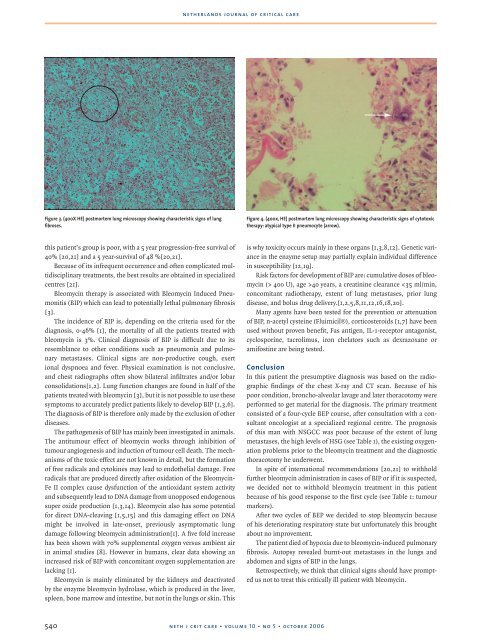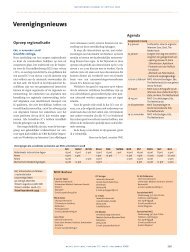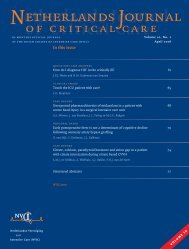Netherlands Journal
NJCC Volume 10, Oktober 2006
NJCC Volume 10, Oktober 2006
- No tags were found...
You also want an ePaper? Increase the reach of your titles
YUMPU automatically turns print PDFs into web optimized ePapers that Google loves.
netherlands journal of critical care<br />
Figure 3. (400X HE) postmortem lung microscopy showing characteristic signs of lung<br />
fibroses.<br />
Figure 4. (400x, HE) postmortem lung microscopy showing characteristic signs of cytotoxic<br />
therapy: atypical type II pneumocyte (arrow).<br />
this patient’s group is poor, with a 5 year progression-free survival of<br />
40% [20,21] and a 5 year-survival of 48 %[20,21].<br />
Because of its infrequent occurrence and often complicated multidisciplinary<br />
treatments, the best results are obtained in specialized<br />
centres [21].<br />
Bleomycin therapy is associated with Bleomycin Induced Pneumonitis<br />
(BIP) which can lead to potentially lethal pulmonary fibrosis<br />
[3].<br />
The incidence of BIP is, depending on the criteria used for the<br />
diagnosis, 0-46% [1], the mortality of all the patients treated with<br />
bleomycin is 3%. Clinical diagnosis of BIP is difficult due to its<br />
resemblance to other conditions such as pneumonia and pulmonary<br />
metastases. Clinical signs are non-productive cough, exert<br />
ional dyspnoea and fever. Physical examination is not conclusive,<br />
and chest radiographs often show bilateral infiltrates and/or lobar<br />
consolidations[1,2]. Lung function changes are found in half of the<br />
patients treated with bleomycin [3], but it is not possible to use these<br />
symptoms to accurately predict patients likely to develop BIP [1,3,6].<br />
The diagnosis of BIP is therefore only made by the exclusion of other<br />
diseases.<br />
The pathogenesis of BIP has mainly been investigated in animals.<br />
The antitumour effect of bleomycin works through inhibition of<br />
tumour angiogenesis and induction of tumour cell death. The mechanisms<br />
of the toxic effect are not known in detail, but the formation<br />
of free radicals and cytokines may lead to endothelial damage. Free<br />
radicals that are produced directly after oxidation of the Bleomycin-<br />
Fe II complex cause dysfunction of the antioxidant system activity<br />
and subsequently lead to DNA damage from unopposed endogenous<br />
super oxide production [1,3,14]. Bleomycin also has some potential<br />
for direct DNA-cleaving [1,5,15] and this damaging effect on DNA<br />
might be involved in late-onset, previously asymptomatic lung<br />
damage following bleomycin administration[1]. A five fold increase<br />
has been shown with 70% supplemental oxygen versus ambient air<br />
in animal studies [8]. However in humans, clear data showing an<br />
increased risk of BIP with concomitant oxygen supplementation are<br />
lacking [1].<br />
Bleomycin is mainly eliminated by the kidneys and deactivated<br />
by the enzyme bleomycin hydrolase, which is produced in the liver,<br />
spleen, bone marrow and intestine, but not in the lungs or skin. This<br />
is why toxicity occurs mainly in these organs [1,3,8,12]. Genetic variance<br />
in the enzyme setup may partially explain individual difference<br />
in susceptibility [12,19].<br />
Risk factors for development of BIP are: cumulative doses of bleomycin<br />
(> 400 U), age >40 years, a creatinine clearance







